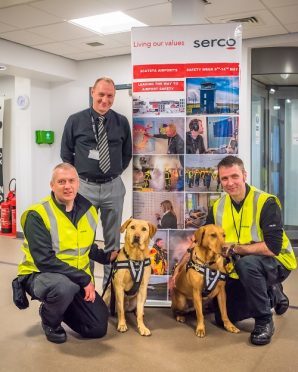These dogs have a nose for trouble.
Four specialist dogs and their handlers from Dogs Against Drugsvisited Scatsta Airport where they went through a series of exercises to help train the dogs and demonstrate their prowess at finding hidden drugs.
The airport is operated and managed by Serco.
In the first exercise, Axel, a Labrador trained to smell drugs in an area, was introduced to four Serco employees who each had a tube at their feet.
Three tubes were empty, but one contained drugs. The dog, which was searching people for the first time, was taken down the line. It sniffed each container and successfully identified the tube with the drugs. It was rewarded by his handler with a ball – its favourite toy.
The dog then carried out two more successful searches for drugs which had been hidden in a staff room and an office.
Currently undergoing training for searching for drugs on a person; on completion the Lab can receive its licence for this element of its training.
Next up was Blade, an experienced Labrador introduced to four more Serco employees, who were sitting in the main terminal building in two rows facing one another.
One had drugs hidden in her sock, but it didn’t take Blade long to find them. The dog sniffed its way along the line of people and once it reached the suspect, sat down in front of her, positively identifying the drugs immediately.
For the second training exercise Blade waited at the side of the flight gate, while the “suspect” followed a group of inbound passengers off a flight into the terminal building. Blade sniffed each and every passenger as they walked past him and immediately detected the drugs and followed the “suspect”, identifying her to the handler.
John Thorne, Serco’s contract director at Scatsta airport, said: “This was a fascinating and useful visit that demonstrated just how good these dogs are at detecting drugs. I don’t think anyone carrying drugs would get past them. Everyone involved in the exercises really enjoyed themselves and we loved the dogs.”
Dogs Against Drugs has a continuous training programme. Puppies start training at around 10 months, and it lasts two years until the dogs are fully trained.










